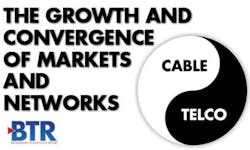Cable, Telco Nets Grow Similar as Markets Converge
A few things can be said about the evolution of the cable and telephone industries during the past decade or so:
- Each has successfully gone after each others residential subscriber base. Cable operators are now the phone company for many and telcos provide as healthy an array of programming services as MSOs.
- The explosion of broadband Internet has given birth to a third dimension, over-the-top players. This is important for a lot of reasons, including the reality that OTT providers are using both cable and telcos as “dumb pipe” conduits to their customers. The trend is just starting: The OTT players are growing more technically sophisticated and building robust back office, fulfillment and content creation capabilities.
- Finally, while the cable industry has had some success in taking commercial business away from the telcos, the industry is truly moving up its game. To date, cable's success has primarily served SOHOs and small- and medium-sized businesses within its residential footprints. It has been far less adept in serving enterprises, which cross more regional borders, demand more and different feature sets and compliance with exacting service level agreements (SLAs). Cable’s parochial legacy – an advantage when dealing with SMBs with centers of operations that more or less match the operator footprint – is a disadvantage to enterprises that doesn’t want to mix and match providers across the country.
